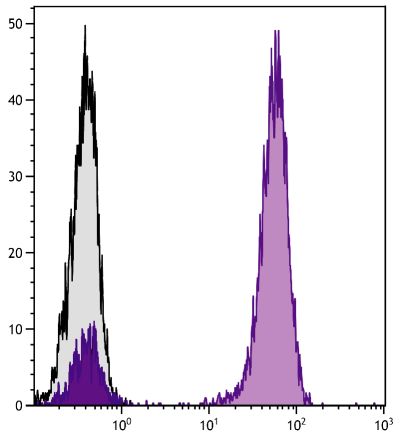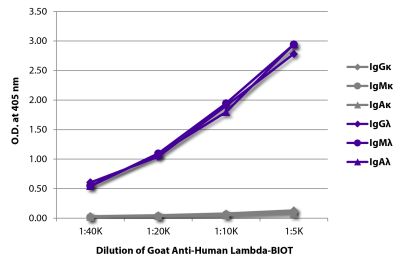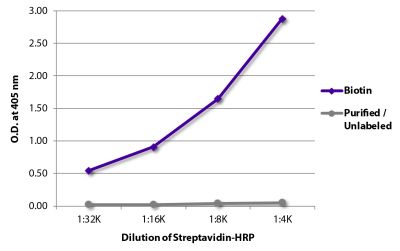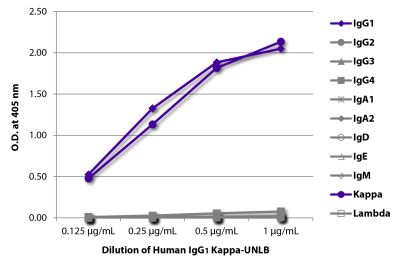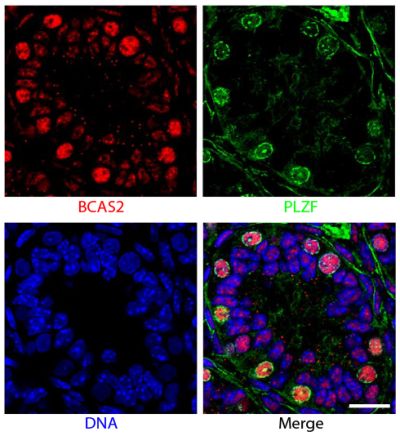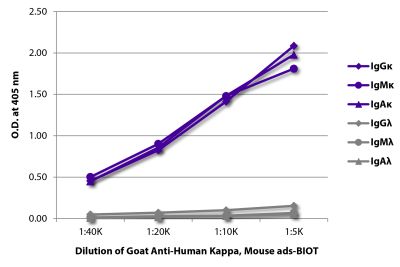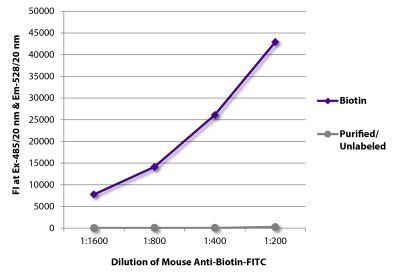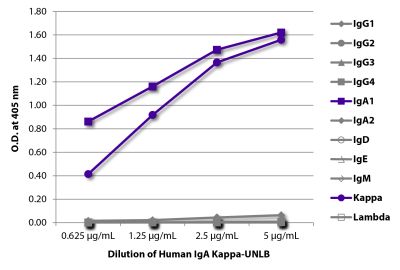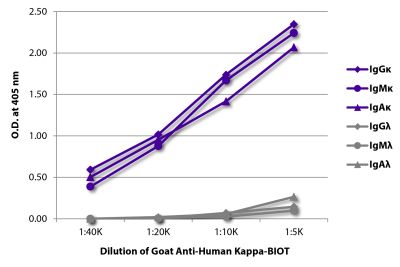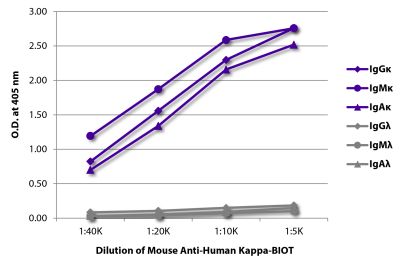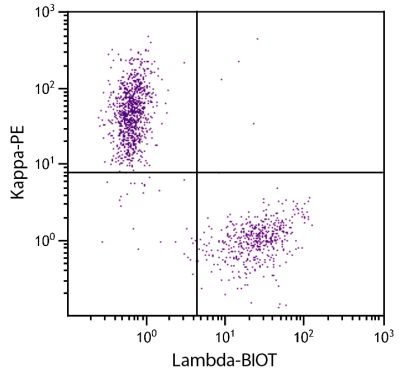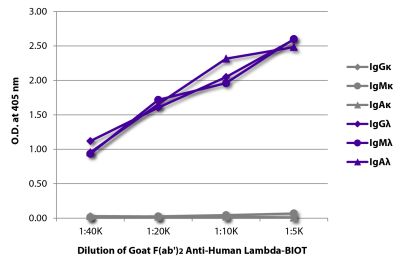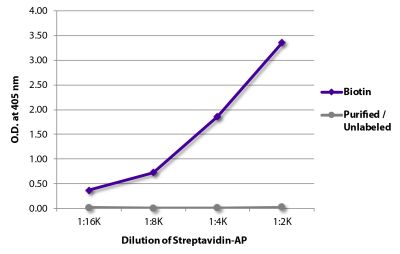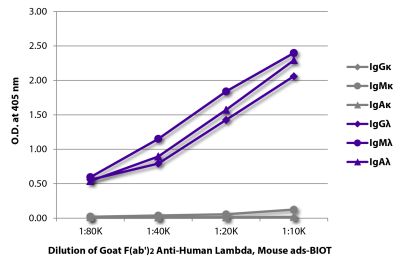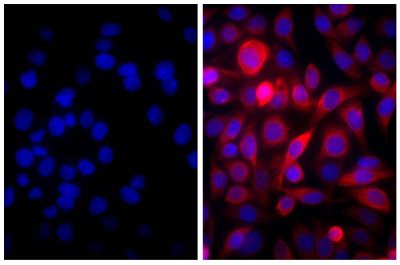Goat F(ab')2 Anti-Human Kappa-BIOT
Cat. No.:
2062-08
Goat F(ab')2 Anti-Human Kappa-Biotin antibody for use in ELISA, flow cytometry, immunocytochemistry, and western blot assays.
$157.00
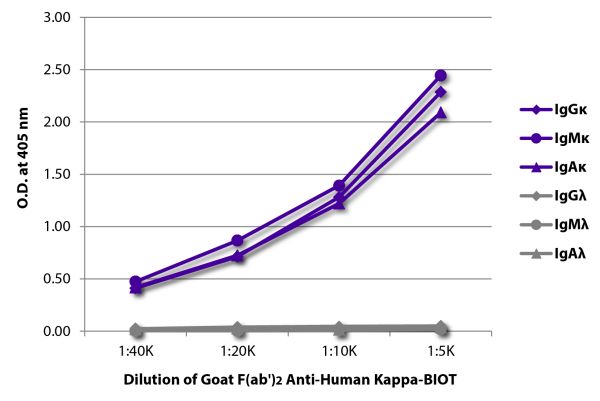


| Isotype | Goat F(ab')2 IgG |
|---|---|
| Isotype Control | Goat F(ab')2 IgG-BIOT |
| Specificity | Reacts with human κ light chains |
| Source | Pepsin digest of Goat Anti-Human Kappa (SB Cat. No. 2060) |
| Cross Adsorption | Human λ light chains; may react with κ light chains from other species |
| Conjugate | BIOT (Biotin) |
| Buffer Formulation | Phosphate buffered saline containing < 0.1% sodium azide |
| Clonality | Polyclonal |
| Concentration | 0.5 mg/mL |
| Volume | 1.0 mL |
| Recommended Storage | 2-8°C |
| Applications |
Quality tested applications for relevant formats include - ELISA 1 FLISA Flow Cytometry 4-8 Other referenced applications for relevant formats include - Immunocytochemistry 2 Western Blot 3 Surface Plasmon Resonance 9 Stimulation 10-14 |
| RRID Number | AB_2795739 |
| Gene ID |
3514 (Human) |
| Gene ID Symbol |
IGKC (Human) |
| Gene ID Aliases | HCAK1D; Km; IGKC |
| UniProt ID |
P01834 (Human |
| UniProt Name |
IGKC_HUMAN (Human) |
Documentation
Certificate of Analysis Lookup
Enter the Catalog Number and Lot Number for the Certificate of Analysis you wish to view
- 1. Li P, Haque A, Blum JS. Role of disulfide bonds in regulating antigen processing and epitope selection. J Immunol. 2002;169:2444-50. (ELISA)
- 2. Beekman JM, van der Poel CE, van der Linden JA, van den Berg DL, van den Berghe PV, van de Winkel JG, et al. Filamin A stabilizes FcγRI surface expression and prevents its lysosomal routing. J Immunol. 2008;180:3938-45. (ICC)
- 3. Macmillan H, Strohman MJ, Ayyangar S, Jiang W, Rajasekaran N, Spura A, et al. The MHC class II cofactor HLA-DM interacts with Ig in B cells. J Immunol. 2014;193:2641-50. (WB)
- 4. van der Pol W, Huizinga TW, Vidarsson G, van der Linden MW, Jansen MD, Keijsers V, et al. Relevance of Fcγ receptor and interleukin-10 polymorphisms for meningococcal disease. J Infect Dis. 2001;184:1548-55. (FC)
- 5. Koch M, Niemeyer G, Patel I, Light S, Nashan B. Pharmacokinetics, pharmacodynamics, and immunodynamics of daclizumab in a two-dose regimen in liver transplantation. Transplantation. 2002;73:1640-6. (FC)
- 6. Beekman JM, Bakema JE, van der Linden J, Tops B, Hinten M, van Vugt M, et. al. Modulation of FcγRI (CD64) ligand binding by blocking peptides of periplakin. J Biol Chem. 2004;279:33875-81. (FC)
- 7. Beekman JM, Bakema JE, van de Winkel JG, Leusen JH. Direct interaction between FcγRI (CD64) and periplakin controls receptor endocytosis and ligand binding capacity. Proc Natl Acad Sci USA. 2004;101:10392-7. (FC)
- 8. Boross P, Lohse S, Nederend M, Jansen JH, van Tetering G, Dechant M, et al. IgA EGFR antibodies mediate tumour killing in vivo. EMBO Mol Med. 2013;5:1213-26. (FC)
- 9. Yang Z, Ramsey J, Hamza T, Zhang Y, Li S, Yfantis HG, et al. Mechanisms of protection against Clostridium difficile infection by the monoclonal antitoxin antibodies actoxumab and bezlotoxumab. Infect Immun. 2015;83:822-31. (Surface Plasmon Resonance)
- 10. Su K, Li X, Edberg JC, Wu J, Ferguson P, Kimberly RP. A promoter haplotype of the immunoreceptor tyrosine-based inhibitory motif-bearing FcγRIIb alters receptor expression and associates with autoimmunity. II. Differential binding of GATA4 and Yin-Yang1 transcription factors and correlated receptor expression and function. J Immunol. 2004;172:7192-9. (Stim)
- 11. Beekman JM, van der Linden JA, van de Winkel JG, Leusen JH. FcγRI (CD64) resides constitutively in lipid rafts. Immunol Lett. 2008;116:149-55. (Stim)
- 12. Arechiga AF, Habib T, He Y, Zhang X, Zhang Z, Funk A, et al. Cutting edge: the PTPN22 allelic variant associated with autoimmunity impairs B cell signaling. J Immunol. 2009;182:3343-7. (Stim)
- 13. Thiel J, Kimmig L, Salzer U, Grudzien M, Lebrecht D, Hagena T, et al. Genetic CD21 deficiency is associated with hypogammaglobulinemia. J Allergy Clin Immunol. 2012;129:801-10. (Stim)
- 14. Habib T, Funk A, Rieck M, Brahmandam A, Dai X, Panigrahi AK, et al. Altered B cell homeostasis is associated with type I diabetes and carriers of the PTPN22 allelic variant. J Immunol. 2012;188:487-96. (Stim)
See All References


